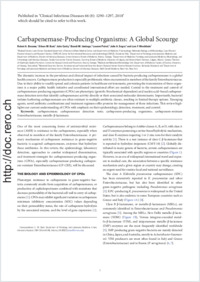Carbapenemase-producing organisms: a global scourge
- Bonomo, Robert A Medical Service, Departments of Medicine, Case Western Reserve University and Research Service, Cleveland, USA
- Burd, Eileen M Department of Pathology and Laboratory Medicine and Department of Medicine, Emory University School of Medicine, Atlanta, USA
- Conly, John Departments of Medicine, Pathology and Laboratory Medicine, Microbiology, and Immunology and Infectious Diseases, Cumming School of Medicine, University of Calgary, Canada
- Limbago, Brandi M Division of Healthcare Quality Promotion, Centers for Disease Control and Prevention, Atlanta, USA
- Poirel, Laurent Medical and Molecular Microbiology Unit, Department of Medicine, Faculty of Science, University of Fribourg, Switzerland
- Segre, Julie A Microbial Genomics Section, Translational and Functional Genomics Branch, National Human Genome Research Institute, Bethesda, USA
- Westblade, Lars F Department of Pathology and Laboratory Medicine and Department of Medicine, Division of Infectious Diseases, Weill Cornell Medicine, New York, USA
-
03.04.2018
Published in:
- Clinical Infectious Diseases. - 2018, vol. 66, no. 8, p. 1290–1297
Carbapenemase
Carbapenemase detection tests
Carbapenem-producing organisms
Carbapenem-resistant Enterobacteriaceae
Metallo-β-lactamase
English
The dramatic increase in the prevalence and clinical impact of infections caused by bacteria producing carbapenemases is a global health concern. Carbapenemase production is especially problematic when encountered in members of the family Enterobacteriaceae. Due to their ability to readily spread and colonize patients in healthcare environments, preventing the transmission of these organisms is a major public health initiative and coordinated international effort are needed. Central to the treatment and control of carbapenemase-producing organisms (CPOs) are phenotypic (growth-/biochemical-dependent) and nucleic acid–based carbapenemase detection tests that identify carbapenemase activity directly or their associated molecular determinants. Importantly, bacterial isolates harboring carbapenemases are often resistant to multiple antibiotic classes, resulting in limited therapy options. Emerging agents, novel antibiotic combinations and treatment regimens offer promise for management of these infections. This review highlights our current understanding of CPOs with emphasis on their epidemiology, detection, treatment, and control.
- Faculty
- Faculté des sciences et de médecine
- Department
- Médecine 3ème année
- Language
-
- English
- Classification
- Biological sciences
- License
-
License undefined
- Identifiers
-
- RERO DOC 309524
- DOI 10.1093/cid/cix893
- Persistent URL
- https://folia.unifr.ch/unifr/documents/306720
Statistics
Document views: 139
File downloads:
- pdf: 288
